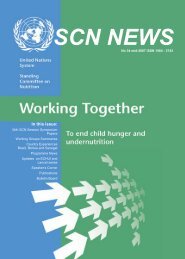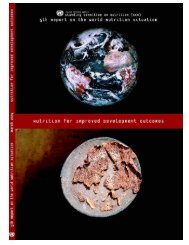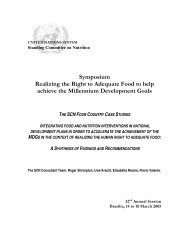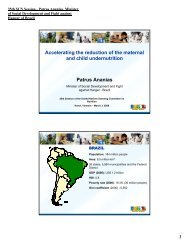Universal Salt Iodization (USI) - FTP Directory Listing
Universal Salt Iodization (USI) - FTP Directory Listing
Universal Salt Iodization (USI) - FTP Directory Listing
- No tags were found...
Create successful ePaper yourself
Turn your PDF publications into a flip-book with our unique Google optimized e-Paper software.
www.unsystem.org/scn FEATURES 53Caldwell KL, Jones R and Hollowell JG (2005a). Urinary iodine concentration: United States National Health andNutrition Examination Survey 2001-2002. Thyroid 15(7), 692-9.Caldwell KL, Makhmudov A, Jones R and Hollowell JG (2005b) EQUIP: a worldwide program to ensure the quality ofurinary iodine procedures. Accred Qual Assur 10:356-61.Copeland DL, Sullivan KM, Houston R, May W, Mendoza I, Salamatullah Q, Solomons N, Nordenberg D and MaberlyGF (2002) Comparison of neonatal thyroid-stimulating hormone levels and indicators of iodine deficiency in schoolchildren. Public Health Nutrition 5(1), 81-7.Delange FM (2002) Iodine deficiency in Europe anno 2002. Thyroid International 5.Gorstein J, Sullivan KM and Houston R (2001) Goiter assessment: help or hindrance in tracking progress in iodinedeficiency disorder control program? Thyroid 11(12):1201-2.Gorstein J, Sullivan KM, Parvanta I and Begin F (2007) Indicators and Methods for Cross-Sectional Surveys of Vitaminand Mineral Status of Populations. Micronutrient Initiative and the Centers for Disease Control and Prevention. (online)Houston R, Lotfi M, Nathan R and Pandav C (1999) Assessing Country Progress in <strong>Universal</strong> <strong>Salt</strong> <strong>Iodization</strong> Programs:Iodized <strong>Salt</strong> Program Assessment Tool (ISPAT). ICCIDD, MI, OMNI, PAMM, UNICEF, USAID, WHO, MicronutrientInitiative, Ottawa.ICCIDD (2007) Iodine requirements in pregnancy and infancy: A WHO Technical Consultation has produced newguidelines on iodine requirements and monitoring in these vulnerable age groups. IDD Newsletter 23(1):1-2.Nathan R (1999) Regulation of Fortified Foods to Address Micronutrient Malnutrition: Legislation, Regulations, andEnforcement. Micronutrient Initiative: Ottawa.Stewart C, Solomons N, Mendoza I, May S and Maberly G (1996) <strong>Salt</strong> iodine variation within an extended Guatemalancommunity: The failure of intuitive assumptions. Food Nutr Bull 17.Sullivan KM, Houston R, Gorstein J and Cervinkas J (1995) Monitoring <strong>Universal</strong> <strong>Salt</strong> <strong>Iodization</strong> Programmes. UNICEF,PAMM, MI, ICCIDD and WHO. (online)Sullivan KM, Shahriari A, Houston R, May W, Mendoza I, Salamatullah Q, Solomons NW, Schultink W, Gross R, Xu Fand Maberly GF (2005) Comparison of different indicators of iodine deficiency in school children. Int J Endocrinol Metab1:1-19.UNICEF (2004a) Achieving <strong>Universal</strong> <strong>Salt</strong> <strong>Iodization</strong> in Georgia: 2004-2005 Plan of Action. Unpublished conferencereport: “Strengthening Partnership for Elimination of Iodine Deficiency in Georgia,” June 25-28 2004, Tbilisi, Georgia.UNICEF (2004b) Sustained Elimination of IDD through <strong>Universal</strong> <strong>Salt</strong> <strong>Iodization</strong> in Georgia 2001-2005. Annual progressreport. Tbilisi, Georgia: Government of Georgia/UNICEF.UNICEF (2006) The State of the World’s Children 2007. UNICEF:New York. (online)WHO/UNICEF (2007) Iodine deficiency in Europe: A continuing public health problem. WHO:Geneva. (online)WHO/UNICEF/ICCIDD (1996) Recommended Iodine Levels in <strong>Salt</strong> and Guidelines for Monitoring Adequacy andEffectiveness. WHO/NUT/96.13, WHO:Geneva. (online)WHO/UNICEF/ICCIDD (1998) Joint WHO/UNICEF/ICCIDD consultation. Review of findings from 7-country study inAfrica on levels of salt iodization in relation to iodine deficiency disorders, including iodine-induced hyperthyroidism.WHO/Afro/NUT/97.2 - WHO/NUT/97.5, WHO:Geneva.WHO/UNICEF/ICCIDD (1999) Progress towards the elimination of iodine deficiency disorders (IDD). WHO/NHD/99.4,WHO:Geneva.WHO/UNICEF/ICCIDD (2001) Assessment of Iodine Deficiency Disorders and Monitoring their Elimination: A Guide forProgramme Managers (2 nd Ed). WHO/NHD/01.1, WHO:Geneva. (online)Zhao J, Xu F, Zhang Q, Shang L, Xu A, Ghao Y, Chen Z, Sullivan KM and Maberly GF (1999) Randomized clinical trialcomparing different iodine interventions in school children. Public Health Nutr 2:173-8.Zimmermann MB, Hess SY, Adou P, Toresanni T, Wegmüller R and Hurrell RF (2003) Thyroid size and goiterprevalence after introduction of iodized salt: a 5-y prospective study in schoolchildren in Côte d'Ivoire. Am J Clin Nutr 77(3):663-7.Zimmermann MB, Aeberli I, Torresani T and Bürgi H (2005) Increasing the iodine concentration in the Swiss iodized saltprogram markedly improved iodine status in pregnant women and children: a 5-y prospective national study. Am J ClinNutrition 82:388-92.Zimmermann MB, de Benoist B, Corigliano S, Jooste PL, Molinari L, Moosa K, Pretell EA, Al-Dallal ZS, Wei Y, Zu-Pei Cand Torresani T (2006) Assessment of iodine status using dried blood spot thyroglobulin: development of referencematerial and establishment of an international reference range in iodine-sufficient children. J Clin Endocrinol Metab. 91(12):4881-7.Contact: kms2@cdc.govback to contents SCN NEWS # 35







